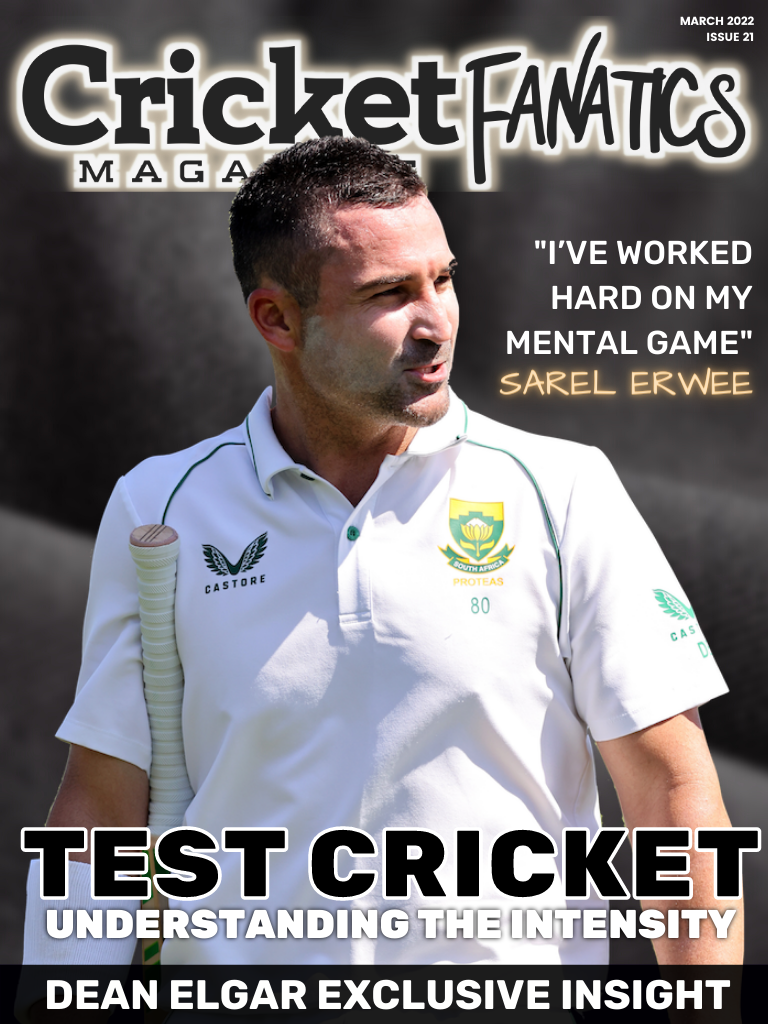
Table of Contents
EDITOR'S NOTE
Understanding the Intensity of Test Cricket
Khalid Mohidin
Founder and Editor - Cricket Fanatics Magazine
Test Cricket has always been the ultimate challenge for cricketers. Whether bowling or batting is your preferred discipline, the intensity of Test cricket is undeniable.
We have seen in the past how incredibly talented domestic cricketers have not been able to make that all-important transition to Test cricket.
I wanted to get an understanding of this intensity and I also wanted to get an analysis of the difference between 4-Day domestic cricket and the Test arena.
So I began my planning. I wanted to get the perfect blend of talent and determination.
So, we start off by chatting with Test captain Dean Elgar, who gave us a true understanding of the struggle some players go through when coming through the system in red-ball cricket.
Not only has Elgar lived the struggle first hand, but, as the captain of the Proteas during this new era, he has seen young and domestically-experienced players come into the setup and fail to show their true ability.
We also spoke to two important newer players - Sarel Erwee and Keegan Petersen – who have toiled away domestically for years before getting their opportunities at the international level.
However, to truly understand the intensity of red-ball cricket, we spoke to Mandla Mashimbyi, the coach of this year's 4-Day Series champions, the Titans. He has an incredible understanding of South African cricket due to his experience in the game as a coach.
He also has worked with some of South Africa's current best players as well as future stars. He gives us his observation on what is needed to become a Test player.
In this issue, we focus on the intensity of Test cricket and what we can do domestically in red-ball cricket to make the transition for players easier.
So sit back, grab a beverage and a snack, and enjoy issue 21 of Cricket Fanatics Magazine.

BECOME A PATRON
By Khalid Mohidin
A very special announcement that I believe will change the face of the way cricket is supported in South Africa.
Hey, guys! Welcome to Cricket Fanatics Magazine. I would like to welcome you to the first and only fan-driven Cricket publication in South Africa.
I started this venture on 1 July 2019 with a vision to get fans from all walks of life engaged with the game and the personalities in cricket.
We want to tell the untold stories of South African cricket and we want fans to be heard.
Since we started, we covered the Mzansi Super League, Women’s Super League, Proteas Men and Women International Test, ODI and T20I series, as well as school and club cricket, with the aim of providing entertaining, engaging and educational content.
But hasn’t stopped there.
We started a Monthly Magazine where we provide multi-media content, including exclusive features, opinion pieces and analysis.
This works hand-in-hand with our YouTube channel where we produce unique cricket shows that allow fans to call in and have their say.
We have the Daily Show, which reveals all the major talking points in South African cricket.The Sunday Podcast Show where we sit back, relax and engage with the live chat, answering all the questions fans have about us and the game.
We have Off-Side Maidens, the first ever All-Women’s Cricket Show on YouTube, which helps empower women in cricket and gives them a place to share their own views on not only women’s cricket but all cricket.
We have a Legends show, where we interview all legends in cricket.
To produce all of this, we’ve invested a lot of money, time and effort to bring this to you for free.
But to keep this going we need your help. So we have opened a Patreon account.
Today, we are fortunate that technology has enabled anyone to become a patron of creative work, even if they are not a billionaire.
We have therefore launched a campaign for you as a Cricket Fan to become a patron and support us as an independent, bootstrapped publisher.
As a Patron, you also get your voice heard as a Fan.
Plus: You have the opportunity to become more engaged with the content we produce.
Every month we produce at least:
- 60 Website Articles
- 20 Daily Video Shows
- 4 Weekly Podcasts
- Match Previews
- Match Reviews
- Video Interviews
- And more…
So please join our Patreon today.
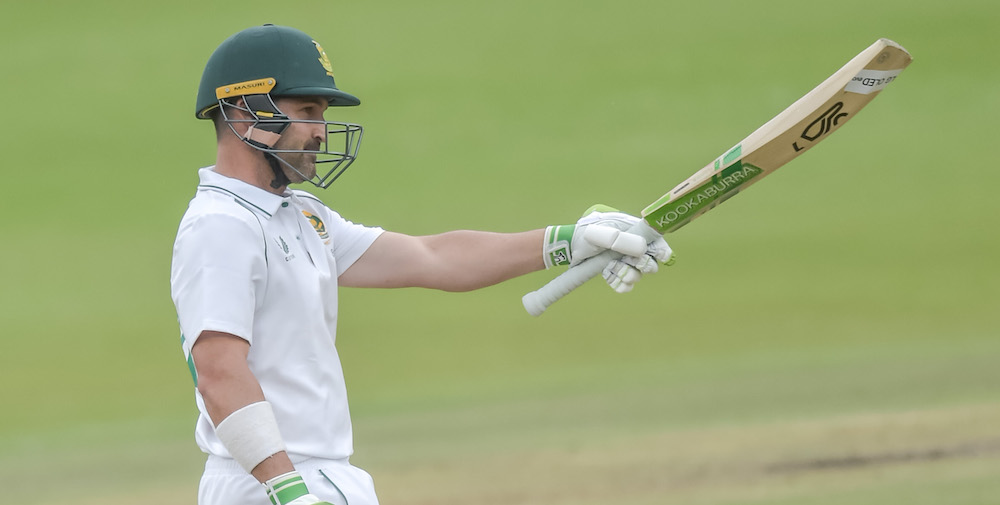
Dean Elgar: Intensity of Test cricket a "massive eye opener"
By Aditya Mehta
In the two years leading up to Dean Elgar’s appointment as South Africa’s Test captain, there was a sense of cynicism in South African cricket because South Africa had lost Test series at home to Sri Lanka and England, and to India and Pakistan away from home.
There was the solitary Test series victory at home against a depleted Sri Lankan side in 2020, which offered a sliver of hope, but this young Test team still had much to prove.
Since Elgar’s appointment as Test captain, South Africa have not lost a Test series. They won against the West Indies and India, and recently drew a Test series against New Zealand.
In an exclusive conversation with Cricket Fanatics Magazine, Elgar reflected on recent results that his team has produced.
“We've almost had to blood a lot of young guys in quite a quick, short span of time, which is not ideal for development of the game, especially when you have to replace five, six experienced players.
"And those guys obviously had to come in and make a play, which is never the easiest thing for a young guy to come and do. But I must say, touchwood sitting here today, it's actually gone quite well for us.
“I can always be hypercritical and say we could be doing a lot better, but I think the situations and circumstances that we faced as a country haven’t been easy for us. And yeah, I'd like to think that we've actually done bloody well considering everything has been against us and everything has been pointing us in the wrong direction.”
Elgar’s most significant challenge has been to ensure that young South African players coming in from the domestic circuit are equipped to deal with the intensity of international cricket.
Elgar pointed out: “The gap between our domestic system and international cricket is two totally different ventures. I don't even think you can put the same two in the same paragraph, let alone the same sentence.
"The intensity that Test cricket brings is so great you can always tell someone about what they can expect. But once you've experienced that firsthand, then that's a massive eye opener.”
When young cricketers are exposed to international cricket, it takes them a while to deliver performances because they have to adapt to its intensity and elevate their skills simultaneously.
“Players take quite a long time to react to that intensity; almost like you need to upskill yourself while you are playing and it's difficult if you haven't done it consistently at domestic level because you haven't had a long period of time playing and that's what's happened with our side.”
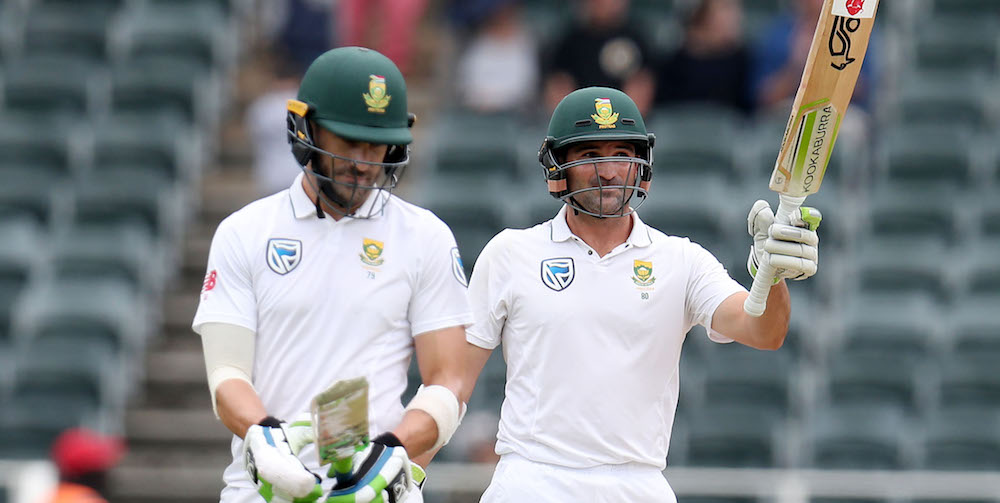
Blooding young cricketers into the Proteas setup is a demanding prospect.
When the team is required to replace giants of the game such as AB de Villiers, Faf du Plessis, Hashim Amla, Dale Steyn, and Morne Morkel over a short period of time, it becomes that much more difficult to deliver consistent results.
Despite the transition that South Africa is working through, the bowling unit is still regarded as one of the best in the world. It is the batters that have struggled to put runs on the board consistently.
Elgar explained: “If you reflect on what you are used to at domestic level, it's not taking away again, the talents of players, but in international cricket, you don't get a lot of loose balls.
"I don't think I've been bowled a cut shot in four years now, and it's only purely because the bowlers that you're facing are the best that the country can offer.
"So they're all coming to the party with different sets of skills, and you need to be mindful of that as well. I think as a batter if you look at it realistically, you have only got one ball to survive, and you can go watch the rest of the innings on the side of the field. That’s the reality.
"From a bowling perspective, you have 20, 21, 22 overs maybe in a day to get it right.”
Dominating with the bat has become increasingly difficult since 2018, particularly because of the rise in bowling-friendly pitches across the cricketing world.
When Elgar took over the captaincy, he stated categorically that he wanted South Africa to revert to the old-school style of gritty batsmanship with big first innings totals.
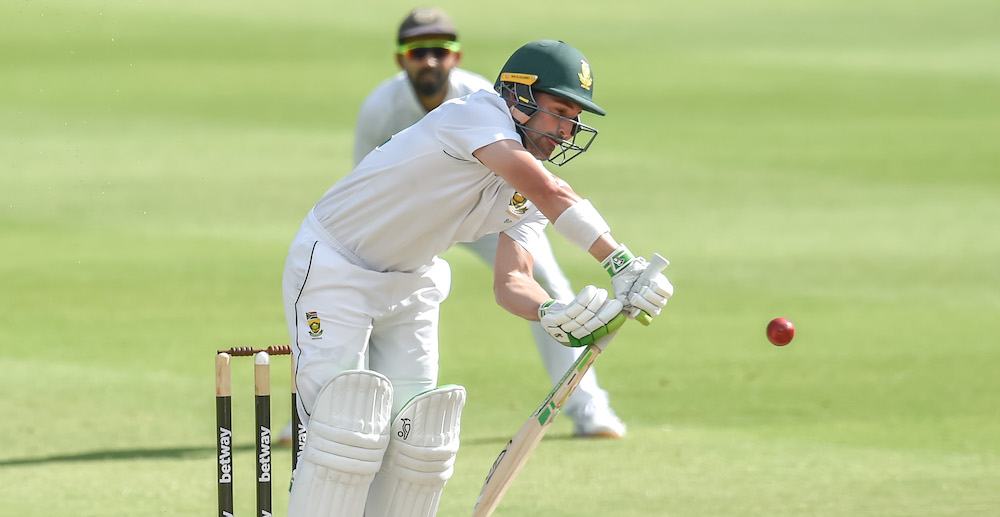
In this interview, Elgar clarified that while he wanted the batting unit to score more hundreds and bowlers to take more fifers, he was cognizant of the fact that it was unlikely to happen immediately.
“If we play that hard upfront in your face intensity, passionate cricket, that's when we are at our best. Look, you can always speculate and speak about “we want to score hundreds and we want to take five-fors.
"I know that's a lot easier said than done sometimes. I'm also very mindful that it's not always going to happen as quickly as we want it to happen.
"That is always going to be a voice in me saying that we want to play an old school way of cricket, doesn't mean we need to play that immediately.
"We needed to build on that, we need to do find our identity with regards to one day, getting that right, and so far we've been we've been doing pretty well.
"I think our squads that we've been working with at the moment, you've got a lot of good characters in personnel, which kind of ties in with it, old school mentality that that I'm looking for.
"Bearing in mind, this is maybe a three, four-year journey that we're all on. So I understand that it's not always going to happen immediately. It's just not realistic with the inexperienced players that we have.
It's got nothing to do with their talent. It's just purely out of age, inexperience in the confidence level that you need to instill in the guys.”
Since Elgar’s debut in 2012, his mental strength in challenging batting conditions has been integral to his success as an opening batter in Test cricket.
Elgar attributes his deep mental reserves to his childhood when he typically trained with individuals who were older than him.
“I think that that is also an aspect that makes you a little bit more harder, bit more stubborn. But I do think it has a role to play when it comes to the mental side of things.
"I think it's even development when I speak of playing backyard cricket with your siblings. For instance, I recall that I didn't want my brother and my neighbor to get me out, and they were a lot older than me – six-and-a-half years, seven years, and eight years older.
"So that also played a role with regards to development. And then you don't know because you're far too young to actually realize and understand the long-term effect that it will have on your mental game.
"But that was definitely a developing factor that played a big role in my psyche now.”
Elgar is also remarkably self-aware and understands his strengths and drawbacks as a batter.
“I know I'm a very limited cricketer. I don't have the talent of de Villiers or Hash Amla. But I do have one set one set of skills and that's to be as stubborn and as proud as possible.”
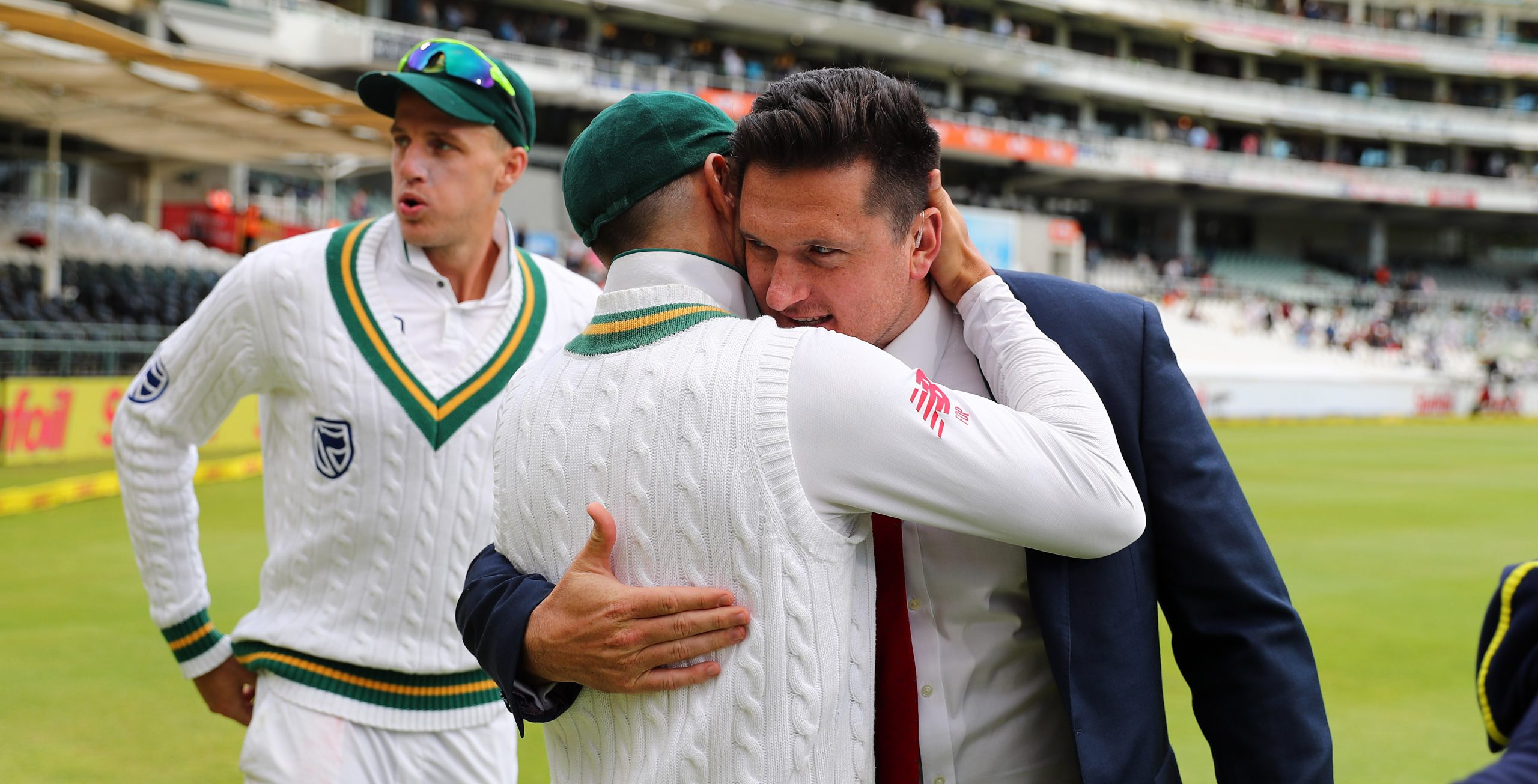
Elgar has played under a number of captains – Graeme Smith, Hashim Amla, AB de Villiers, Faf du Plessis, and Quinton de Kock – and he has imbibed a variety of lessons from all of them.
“I've had Graeme, AB, Hash, Faf quite a lot of the big dogs around me. But I've learned a hell of a lot more from Faf. Because I think I was a lot more hands on. He gave me a lot more responsibility within the team from a leadership point of view being one of the older, more senior players around.
"So I think he almost allowed me to groom into a position of leadership, which just happened naturally because I think my personality always needed me to gravitate towards that kind of position. And I've taken small little things out of it, the things that I've liked and the things that I haven't liked, obviously, stuff I won't be using.
"But yeah, I think you'll be stupid not to want to use those guys as the tools and resources to make yourself better firstly, and then obviously, to make the change room better.”
While Elgar has learned from previous South African captains, he wants to ensure that he is constantly evolving.
“I'd like to think philosophy is still a work in progress, I'd like to think I don't want to be a one-dimensional kind of captain, I want to evolve with the players that are around me, which can only benefit me in the long run.
"But also being extremely true to myself, I think my nature, my character, is one that most players will gravitate towards because I don't like losing, I hate losing.”
Over the last two decades, data has become an important part of a cricket team’s preparation for a series. Some players are more inclined towards using data to develop their plans, other players rely primarily on instinct.
Elgar is not particularly data driven, but understands that there is plenty of scope for data analysis in aiding a team’s performance.
“I'm not a massive data-driven person. I think you need to simplify the game as best as you can, not just for yourself, but for your team. Look, I do think there is room for data within our within our game.
"But if you're not a data numbers, watch videos analysis person, it's difficult to force someone to do that. And that potentially is taking them out of the natural way of playing the game.
"Being a captain, I need to obviously have a look at opposition players to see their strengths and weaknesses, no doubt. But also, I don't think you must forget about your strengths and weaknesses, which is what you need to try and control. And that's what obviously you have to execute when you hit the park.”
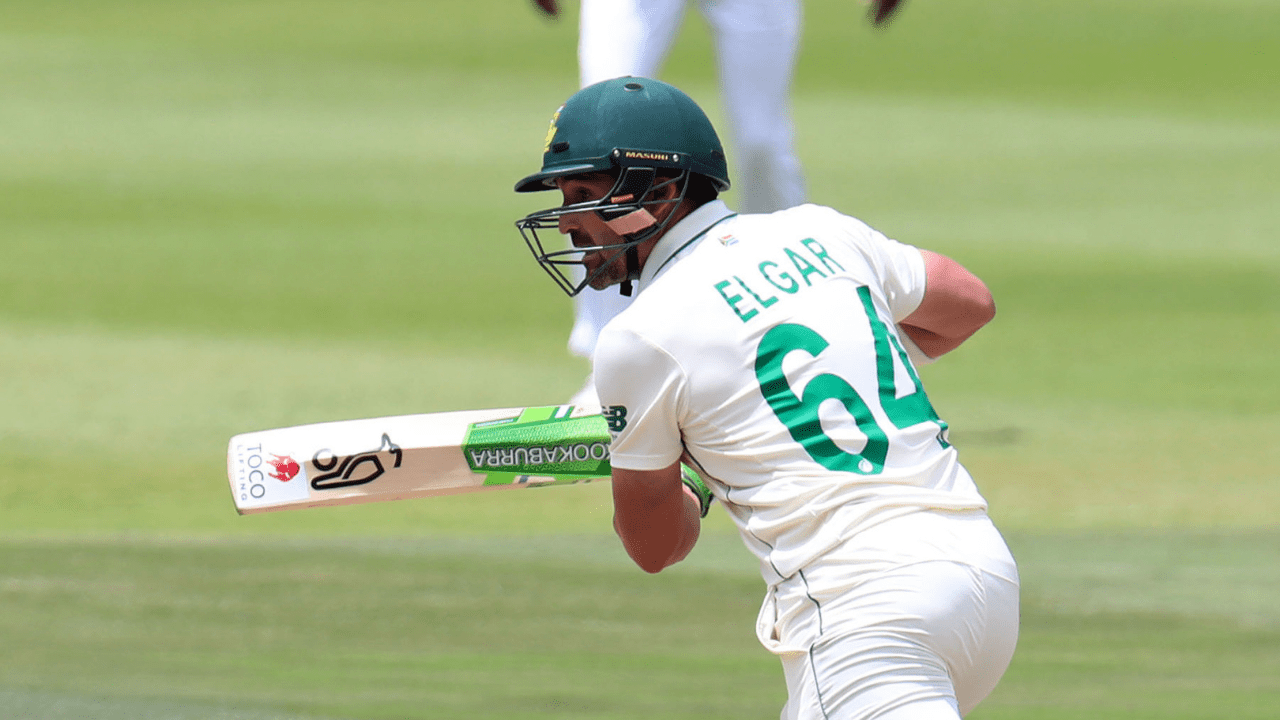
Although South Africa’s bowlers have delivered consistently for the team, world cricket has witnessed a significant decline in the number of bowlers who can clock 150 km/hr and beyond.
Elgar believes the dearth in bowlers who can bowl express pace is a product of the volume of cricket played in current times.
Elgar explained: “I think workload is a massive thing that has that has played a massive role and impact on that. If guys want to play international cricket, IPL, and Big Bash.
"I mean, sooner or later, your body is going to start telling you, 'Listen, I can't perform at the level you want me to perform. But here is my capacity currently and if you want to overstep that, that's when you break down.'
"So I think the demand on players to be that 140-145 + is extremely demanding still, but with the with the volume of cricket around currently, I don't think it's very realistic for the guys to operate at that level.”
Given that Elgar’s team is young and inexperienced, he offered extensive insight into how young players should approach their careers. Patience, Elgar said, was key to success in professional cricket.
“I think a lot of young cricketers expect too much when they leave school. And when they leave school, they are just part of a big world out there and they don't deserve anything coming their way because they haven't really achieved anything out of school.
"But patience is something that jumps to mind. If I reflect on what I went through as a school cricketer to after school and development into professional cricket, I was extremely patient to wait for my turn.
"But also along the journey I made sure that no one forgot about me because I scored a lot of runs in my younger years.”
No one forgot Elgar in his younger days, and going by his career in international cricket, it is unlikely that the South African cricket community will forget him anytime soon.
His tough and gritty approach to cricket serves as a reminder of South Africa’s golden era. If the fans, just like young cricketers, remain patient, they will find that Elgar can lead South African cricket into a new dawn, which we may refer to as the start of another golden era.
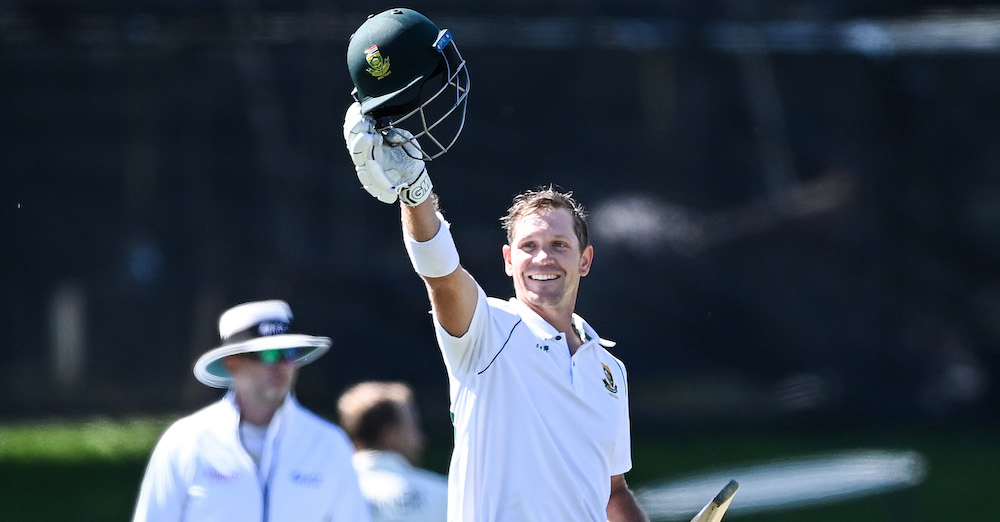
Mental strength key in Sarel Erwee’s progressive game
By Marc Jacobson
Sarel Erwee achieved a long-awaited and “lifelong” dream by making his Test debut for South Africa against New Zealand in February and he has attributed his mental fine-tuning as a large contributing factor to making that successful step-up.
The 32-year-old, who made his first-class debut back in 2008 for South Western Districts, got his Test entrance off to a decent start when he scored a century (108) against the Black Caps in their second Test in Christchurch, which they subsequently won by 198 runs.
It was only Erwee’s second appearance for the Proteas and he top-scored in the first innings to help his side post a leading total. It was a belated ingress for him, but the mental adjustment he had to make after years of playing 4-day cricket was pivotal.
“Over the last two years I’ve worked really hard on my mental game,” Erwee told Cricket Fanatics Magazine.
“I’ve played cricket for so long and hit so many balls as a batter in my career that I felt if I wanted to make a step-up to Test cricket, or do even better in franchise cricket, I had to work on my mental game.
“Even if it meant I’d improve by five to 10 per cent, I felt like that’d take my game to the next level. Mentally, I had to follow the processes and stick to those processes that I’ve been working on with a sports performance coach.
“That’s kept me calm in certain situations and it’s [helped me] to be able to control my body in big moments. Following processes keeps me in the moment and [prevents] me from thinking too far ahead, [while ensuring me that] I can control what I can control.
“Working on mental strength that can improve your game is a big part of my game at the moment.”
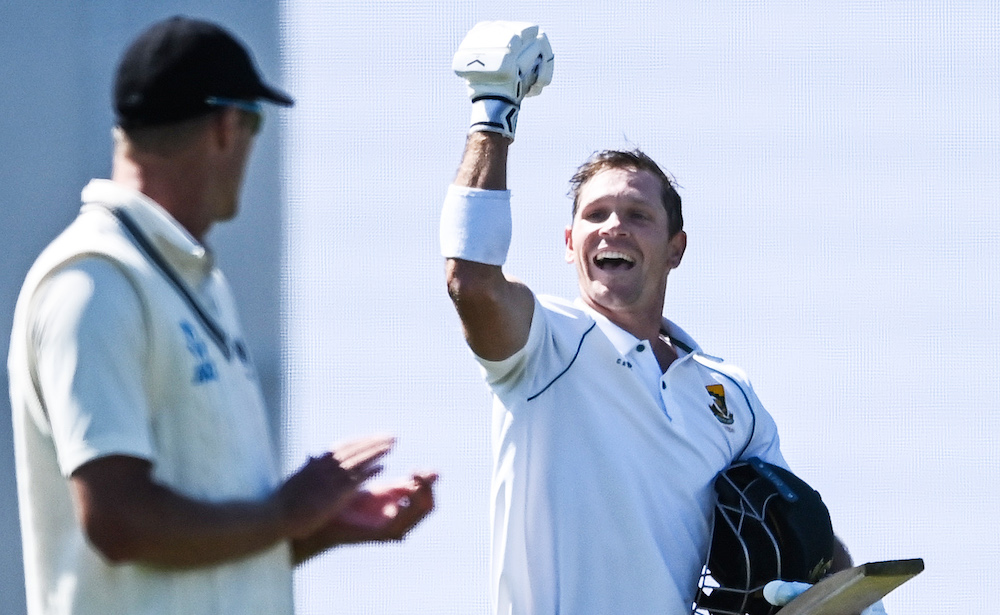
Erwee was tasked to take on the best Test side in the world while playing in New Zealand’s conditions, an arena where many of the best teams have fallen short in recent seasons.
Having been thrown into the deep end, so to speak, Erwee marked the “intensity” of such a step-up as one of the main differences to what he has experienced before in red-ball cricket.
“Their bowlers don’t let up in their good areas – they’re always on the spot for a lot longer than the bowlers in franchise cricket. You get tested a lot, technically, but that’s also something you can kind of fix.
“You might not get it correct, but that’s where the mental part of the game comes into play.
“But the bowlers are relentless in not missing their areas – they’re on the spot testing your technique, defence and patience. You’ve got to find a way to score and to find your breaking point of taking it a touch further than the bowler.”
Scoring a Test century amid adversity, in the context of SA having been well-beaten in the first Test and with Erwee opening the batting with Dean Elgar in their next outing, was an “unforgettable moment” for him.
“It was an amazing feeling, something I’ve dreamt about and worked towards for so long. I probably won’t forget that moment for the rest of my life, just because of the nature of how my career has progressed and gone,” Erwee said.
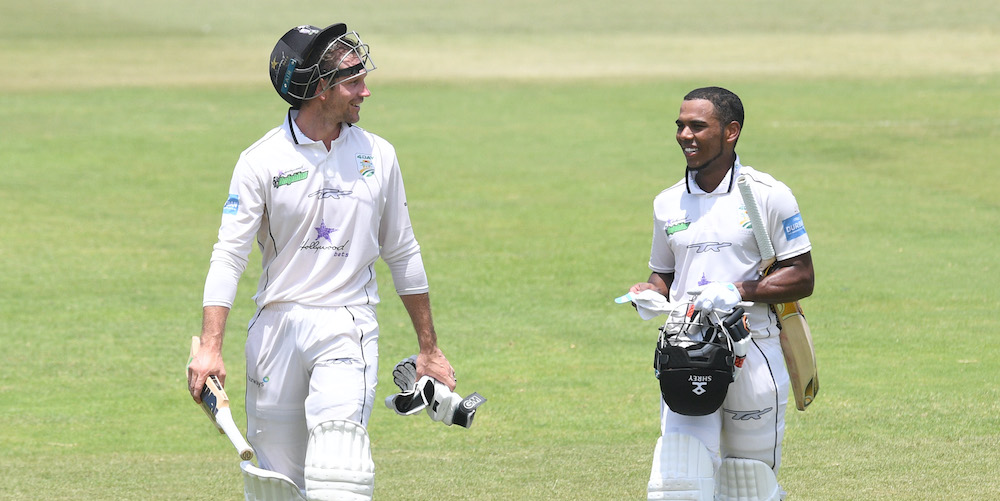
The Dolphins batsman said the resilience he had to showcase, in light of that, tied in with the mentality he’s been working on, largely because getting that chance was also a “lifelong goal” for him.
“I can only control the controllable so if I do the correct things then everything else will take care of itself. Building up that resilience was about working on my mental game and giving myself the best opportunities to do well.
“It was about sticking to the basics and trying to fight every ball for the team, [especially] after the position we were in after the first Test – we were backs against the wall – and you had to show your worth and fight as a South African. I used that to motivate myself during that innings.”
Having gotten a taste of what Test cricket is about, the ability and tenacity required to “fight” for every ball has taught Erwee some valuable lessons which he’d certainly heed to moving forward.
“I’m quite an optimist and I’m optimistic that if I work hard and do the correct training sessions and analyses while following my mental processes, and practice those things day in, day out that you will achieve the goals that you set for yourself."
Get More Clients With Cricket Fanatics Magazine
Cricket Fanatics Magazine has the visibility, infrastructure, expertise and toolset to automate your marketing and branding.
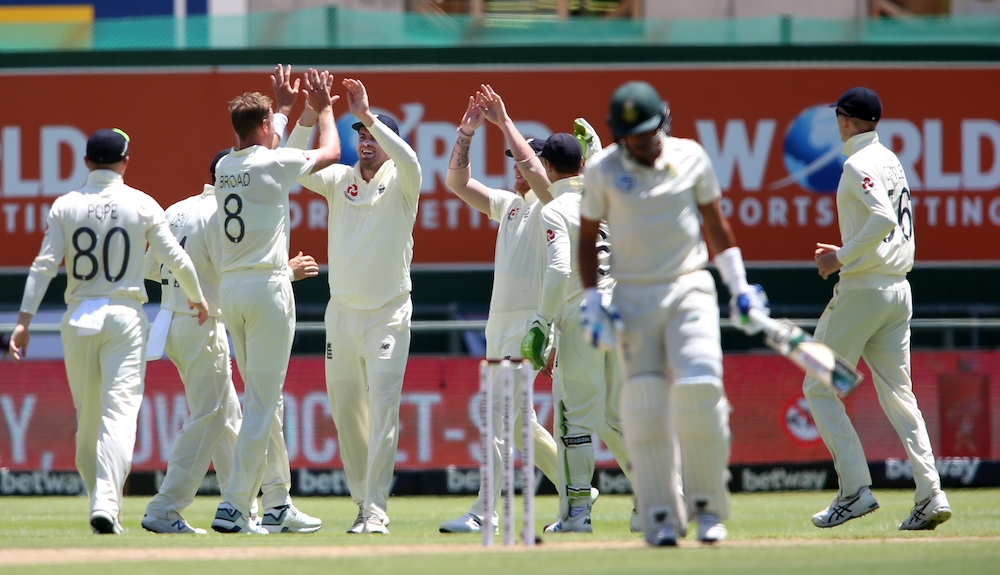
The Challenges of Red-Ball Cricket
By Khalid Mohidin
The following interviews with Zubayr Hamza, Ryan Rickelton and Sinethemba Qeshile will give you a wholistic understanding of red-ball cricket in South Africa.
We listened to their stories and what they have learnt on their journey so far.
RYAN RICKELTON
First up was Ryan Rickelton who has been an integral part of the Lions side, and also showed his class in the red-ball format for South Africa A.
Although his excellent performances in the white-ball arena saw his popularity grow in that format, he has regularly performed in the red-ball arena too and he discussed the development of his mental and physical side of the game.
This saw him called up to the national set up in the long format.
SINETHEMBA QESHILE
Next was Sinethemba Qeshile who broke onto the 4-Day Cricket scene for the Warriors with a string of half-centuries. But his second season for the Warriors was not as great as his maiden season.
Although it's in the long format that he made his name as a junior, he made his debut in T20 cricket for South Africa. He also was selected in the SA A side, scoring a century in the long format. He discusses the lessons he learnt so far and particular the step up to 4-Day Cricket.
Daniel Smith
A young wicket keeper batter who is making aves for WP Blitz in multiple formats. Here he speaks about the step up to domestic cricket after a quick rise into professional cricket.
Advertisement
Ezra Poole's Online Wicketkeeping Academy
Learn how to Master The Craft of Wicketkeeping Without Having to Hire a Full-Time Personal Coach.
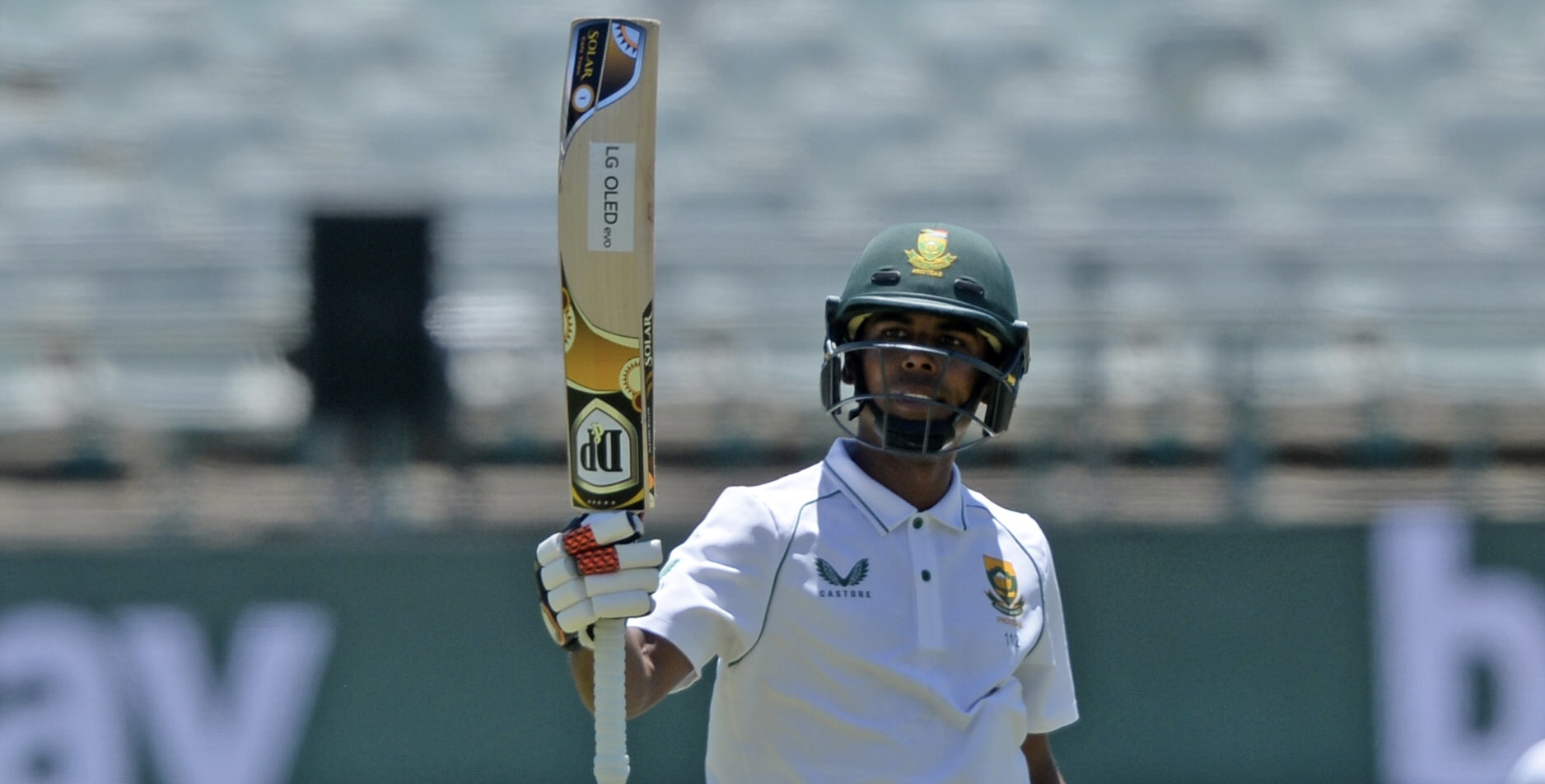
Keegan, the Kid from New Orleans
By Chris Chiwanza
“He is very specific around his preparations. He understands his game well and knows what he needs prior to fixtures,” Imraan Khan on Keegan Petersen.
Keegan Petersen could become an all-action cricket figure, he bats, he bowls and he keeps. Two of these three are services that the Proteas might not ever need from him. But he is capable.
He hasn’t bowled much since turning professional and has kept wicket for Dolphins more than he has bowled. Though he now mainly bowls at training, he started bowling leggies as a teen.
Wicketkeeping is a recent development. Imraan Khan, his Dolphins coach, needed a substitute wicketkeeper.
“We didn't have a second keeper in our squad,” says Khan. “It was put to him if it was a role he would be considered if there was a need for it. He didn't think twice.”
This probably defines Keegan. According to Imraan, Keegan’s words were, "I will do what the team needs."
The other day a reporter asked him about his preferred position in the Proteas line-up, and his response was also along these lines.
He will bat anywhere where the team feels he is needed. As long as he plays and contributes to the team, he is not fussed about everything else.
“And he kept outstandingly well in the games that we needed to execute that role,” says Khan.
Keegan Petersen is a team man through and through.
In many ways, Keegan is like his father. Both are short men. I think diminutive is the term some would prefer.
Diminutive and competitive. According to a few people, Dirk Petersen didn’t give an inch either on the cricket or rugby field. Diminutive and competitive team men.
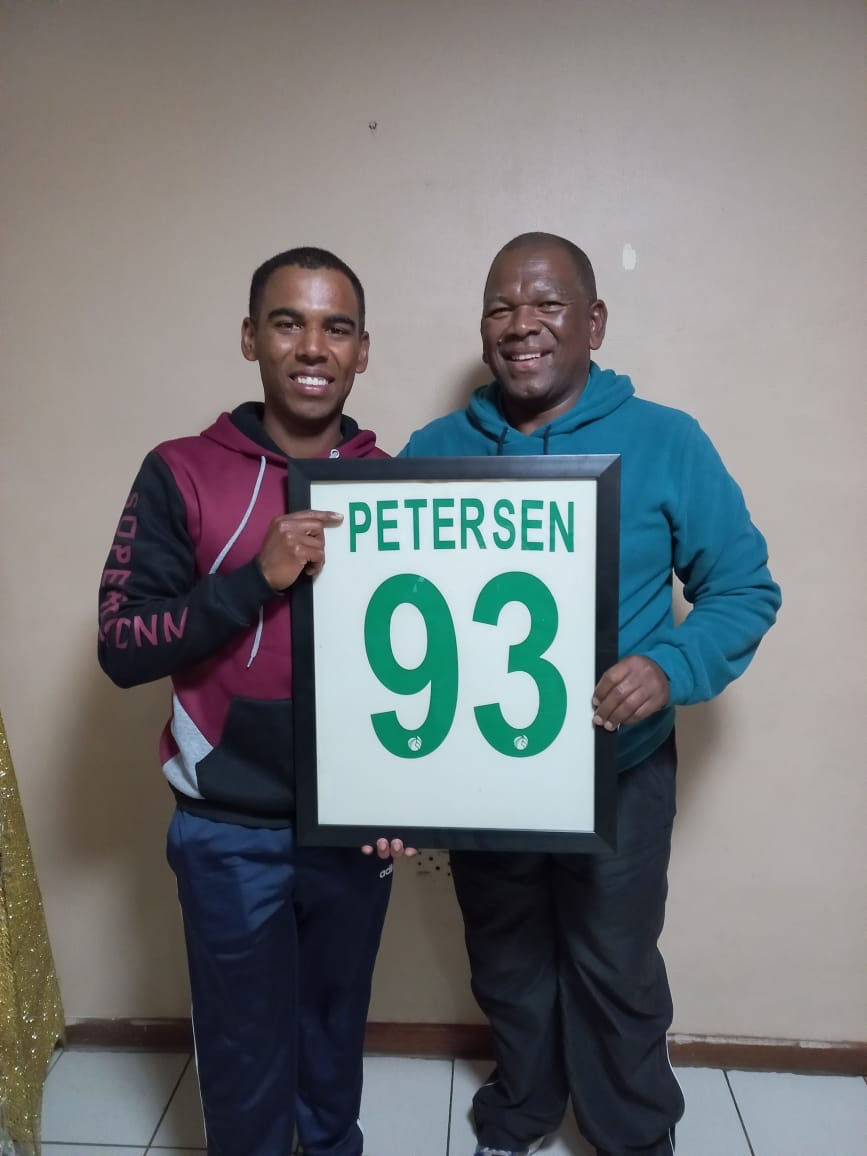
The first thing that I learned about Dirk Petersen, Dirkie, is that he was a proper team man. The second is that he cried when Keegan made his debut for the Proteas. They were tears of joy.
Dirk Petersen knew how much his son had fought to get to this point. He had come a long way from the days when he couldn’t nail down a permanent slot at Cobras, now Western Province.
In his 3 years with the side, Keegan had only started in 7 games. What followed was a bit of a nomadic spell. He played for Knights and Northern Cape before settling at Dolphins in 2020.
It was too bad that his international debut would not be on home soil, the Proteas were on tour to the Caribbean. Anywhere in South Africa, the Petersen family would have made the trip in the same way that everyone had made the trip to Boland Park to watch Keegan make his debut for Boland.
19-year-old Keegan made a 44 that day. Keegan went on to have a two-year semi-pro career with Boland. In his second year with the side, he scooped the award for the semi-professional player of the year. The next year he scooped another CSA award.
The third thing that I learned about Dirkie was that he was an “all-round sportsman.” It’s a phrase that came up a lot as I asked people about him. He played provincial rugby and cricket in his day. He was a fleet-footed fullback and was a good batter for Paarl Cricket Club. He was Umpire Marais Erasmus’ teammate at Paarl.
Years, possibly decades, after his last competitive rugby or cricket match, Dirkie still dresses the part, tracksuits and trainers. This is how many kids he taught remember him. He only dressed formally for classes, he is a teacher at New Orleans Secondary School.
This is where Keegan’s journey started, at New Orleans Secondary School. That is the school that Justin Ontong also attended. Two Proteas is a lot for a community school in Paarl. Not many professional cricketers who make it all the way come directly from community schools.
South Africa has a certain pathway for developing young cricketers. One way or the other, talented youngsters have to pass through the major cricketing schools, Grey College, KES, St. Stithians and others.
On average, kids who attend these schools have a better shot at representing South Africa at Under-19 and moving on to professional cricket. Their path is a lot smoother. Those who can’t afford the fees go through scholarships.
Keegan didn’t go down that route. A lot of things about Keegan’s journey are like that. Despite his obvious talent as a youngster, he never played first-team cricket.
He started his career at 11, and from 11 through to the time he made the Boland Under-19 side Keegan never played first-team cricket.
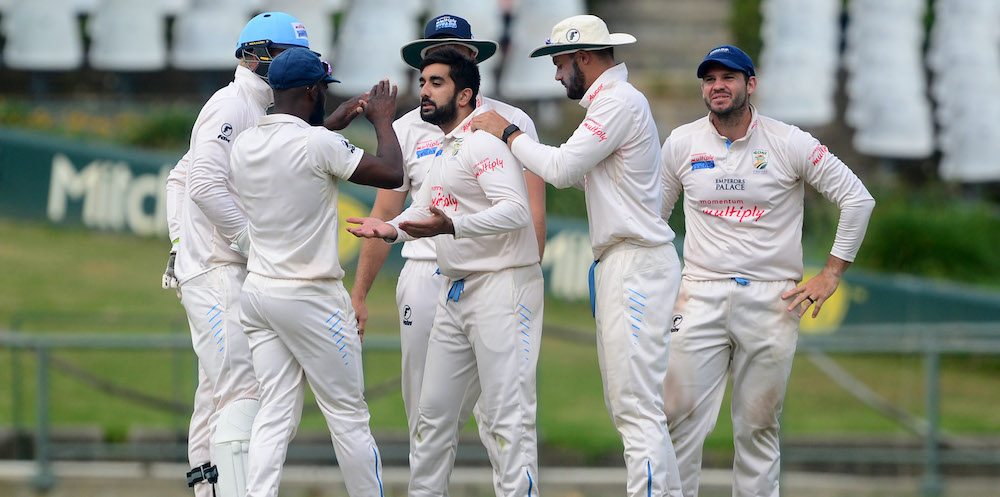
In many ways, his path reminds me of Tabraiz Shamsi’s. Shamsi performed very well as a youth, but just never seemed to get the attention he deserved at the time.
At 15 Tabraiz attended a camp. He took the most wickets and was the player of the tournament. But he didn’t make the A-side. At semi-pro he only made the Gauteng side after the guy earmarked for the position was called up to the Proteas Under-19 side. Only earned promotion as a placeholder.
Anyway, Keegan stayed on at New Orleans Secondary. His father could have sent him to Paarl Gymnasium, where Justin Ontong completed his education. But he didn’t. It was probably not a financial decision.
Dirkie probably kept his kid at New Orleans because he probably felt that he understood Keegan better and knew best needs better than anyone.
There is a King Richard vibe about his attitude towards his son’s cricket career. He always tried to put Keegan’s needs first.
Dirkie was never keen on accompanying Keegan to trials. He felt that it diverted attention from Keegan’s abilities and would centre it on him being Keegan’s father.
Dirkie was something of a local legend.
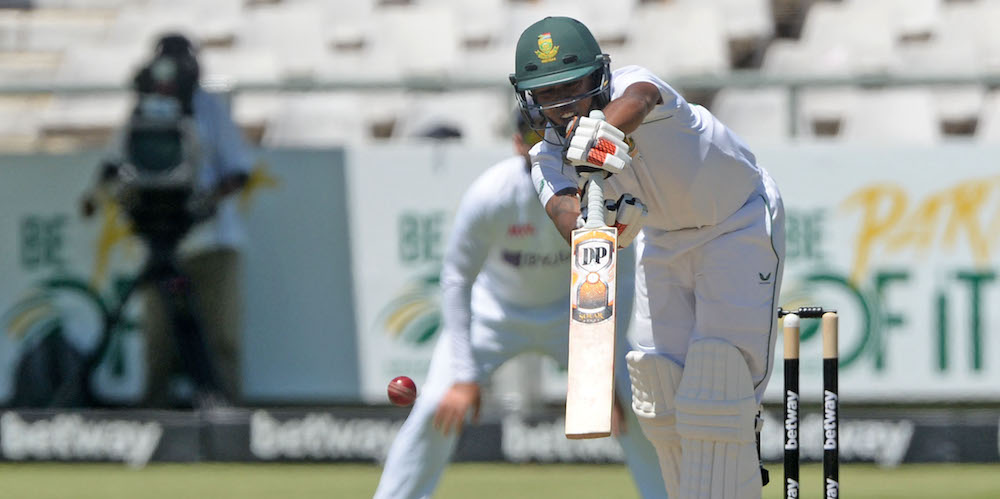
Whatever the reason, Dirkie’s decision to keep Keegan at New Orleans Secondary worked out very well in the end. So well that Keegan debuted for Boland at 19.
Not just that, but the technique that has brought him success, allowed him to dominate First-Class cricket and do well at international level, is the technique that his father drilled into him. The two spent countless hours throwing thousands of balls in the nets.
"I have batted the same way since I was a kid. It's because of my dad, he's the only guy I have been working with all my life.
"I always tell everyone that he probably knows my technique a lot better than me," Keegan shared in the post-match interview following his maiden Test half-century.
And now, he is now his own man because of that technique. In New Orleans, it is no longer Keegan, Dirkie’s boy. It’s now Dirkie, Keegan’s father.
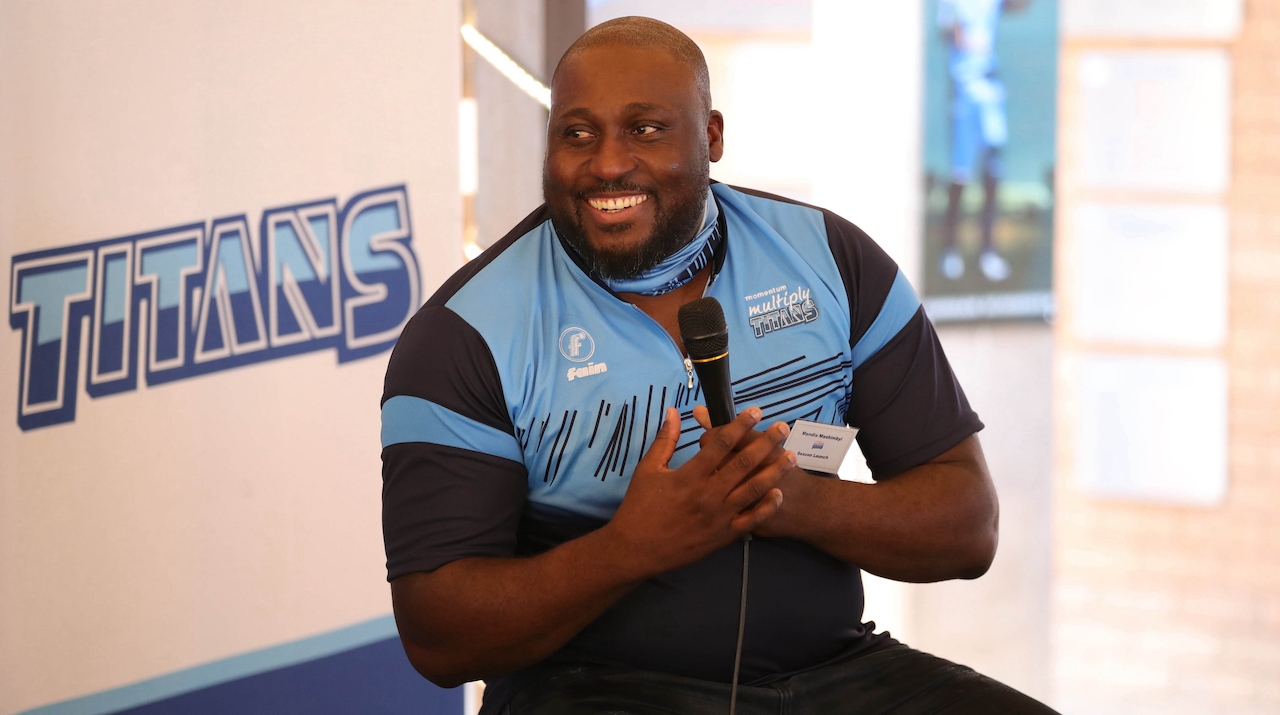
Mandla Mashimbyi on winning 4-day competition with Titans
By Keanan Hemmonsbey
Four-Day Domestic series trophy-winning coach, Mandla Mashimbyi, speaks about what it takes to make the step up to international cricket.
Mandla Mashimbyi led the Titans to the first Four-day trophy since the return to the provincial, two-tier system was reintroduced in 2021.
Mashimbyi’s Titans team is littered with experienced international players such as Junior Dala and Lizaad Williams as well as players with Test match experience in Simon Harmer, Theunis de Bruyn and Heinrich Klaasen.
This ensured the Titans squad remained formidable in their quest for domestic glory. Their campaign, however, got off to the worst possible start. The Titans found themselves languishing in seventh position after two rounds of action.
The formula for turning their fortunes around started with a mental shift, according to Mandla Mashimbyi, Titans head coach who spoke to Cricket Fanatics Magazine exclusively.
“We just had to make a mental note, mental commitment to say ‘listen, guys, we need to step out of this now and actually get up and going’ and as a team and leadership group said ‘listen, this is how we’re going to do it’
"People really started getting attached to the badge and understanding what it means. We have a legacy to look after and we have a legacy to leave behind. We have to leave this place better than we found it,” said Mashimbyi.
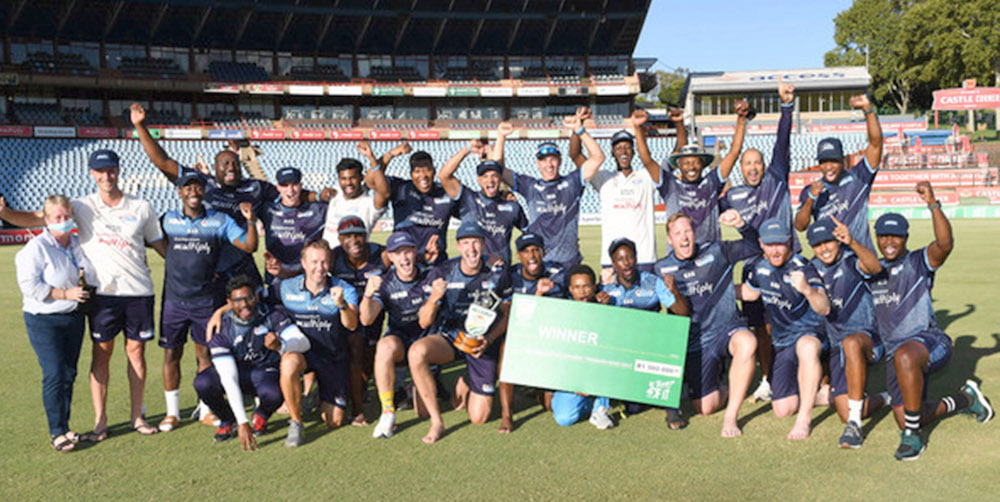
The right headspace for growth
These mental shifts are important for players to develop at domestic level in preparation for the trials and tribulations of Test cricket. Being able to pick yourself up after being down is an important trait necessary to thrive at the highest level.
However, the onus is ultimately on the player to develop and grow their game whilst plying their trade at domestic level, according to Mashimbyi.
“It starts with the player himself to be honest. When they come into the [professional] environment they need to have some sort of goals and ambitions and desires to play for their country.
"What you do then as a coach, you provide an environment that’s going to be conducive to that player's progress that’s going to enable him to eventually get to the next level. For instance, at the Titans, we pride ourselves on our work ethic and how we train.
"We need to be deliberate in terms of how we train and that will put things together for the player to make sure that when he makes the step up, he doesn’t feel out of depth and that he will fit in with what’s required at international cricket,” said Mashimbyi.
Creating the perfect environment to foster that growth, however, is the job of the coach, according to Mashimbyi.
“Creating environments where players feel like they belong, creating environments where he feels like he’s got a voice, creating environments where he or she feels he can grow from a skills point of view and as a person as well. That for me, speaks to a lot of coaches’ ability,” said Mashimbyi.
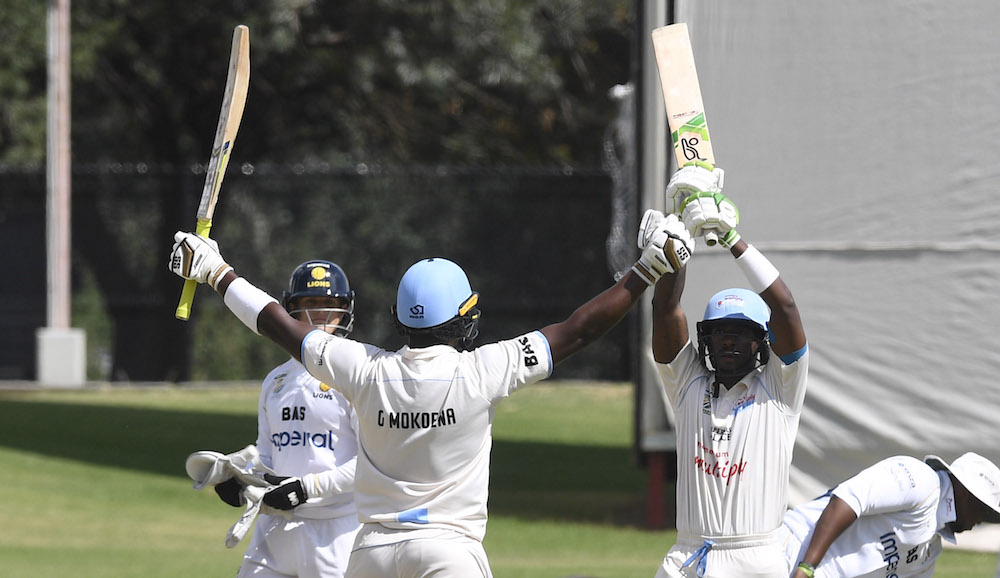
Building partnerships
Creating open relationships with players is vitally important for a coach. Cricket coaches act more as a mentor for players compared to other sports where coaches are more actively involved in the play-by-play actions of their team, on the field. Whereas cricket coaches focus more on the long-term development of players.
“As the coach, you want to be a sounding board, you want to be the guy that asks the right questions, you want to be the guy that brings clarity in terms of the mindset that the player needs to carry throughout their playing career. How you challenge a player is to ask where he wants to go and what are the things that are required to get there,” said Mashimbyi.
Building and sustaining that relationship between player and coach enables the future sustained success of the player.
“Then you actually get the player to believe in processes because we all want to be somewhere but we forget that we need to do certain things to get where we want to,” said Mashimbyi.
Building pressure from one end
Many Test cricketers make their debut later in their career, some even in their 30s. Mashimbyi believes this is important as players are able to perfect their craft at domestic cricket and then immediately excel at the highest level.
“I think you get your exception, you get players that just figure out their mode of being good and are just world-class at a young age but they make up a small percentage. I think the rest, think they need to ‘pay their school fees at the provincial level.
"Fail, succeed, fail again, succeed, until you get to the point where you understand what it means or what it takes for you to be successful,” said Mashimbyi.
Mashimbyi uses Vernon Philander as an example of someone who spent a long time plying their trade at domestic level and used that time to iron out any creases in his game.
“Look at Vernon Philander, he played provincial cricket for the longest time. He understood his game, he took time to be who he is in world cricket. When his time to step up came, he understood exactly what he needs to do, how he needs to do it. I think a lot of people need to take a lot of learning about how he went about things.
“I don’t think Vernon played for 10 years but he’s one of the greats. So people need to look into actually saying 'I want to accumulate as much as I can from an experience point of view, provincially, so that when I make the step up, there’s there are no holes in my game that will hinder me being a successful international player,' says Mashimbyi.
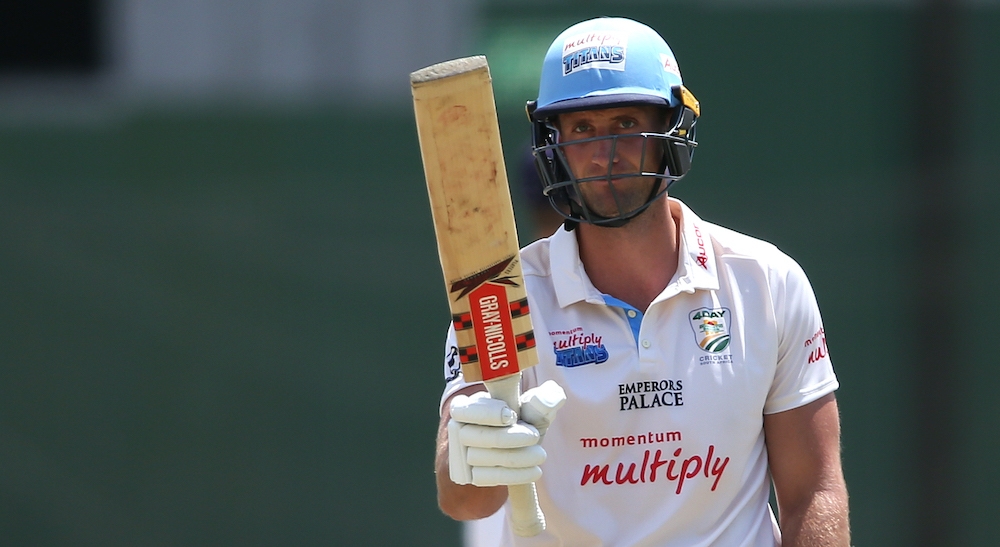
Turning over a new leaf
Titans middle-order batter, Theunis de Bruyn, is one of the exceptions Mashimbyi speaks about. The lanky right-handed batter made his Test debut at 24-years-old in 2017, an age relatively young for Test cricket.
Despite having a Test match century behind his name, de Bruyn struggled to establish himself in the Proteas team, averaging a meagre 19,45, and ultimately being dropped in 2019.
However, De Bruyn, now 29 years old, has emerged as a big-game player for Mashimbyi. In the Titans’ final game of the Four-day cup tournament against the Lions, a game they needed to win to clinch the title, De Bruyn scored an impressive 143 which played a big role in determining the outcome of the match and ultimately the title.
Second chances need to be extended to players who have gone back and proven they can succeed at Test level, even if they have failed as youngsters before, according to Mashimbyi.
“Theunis is a world-class player, he’s been through a lot in the last few years. The Theunis that I’m seeing this year is bringing new energy, he’s hungry to succeed.
"I think it won’t be long before we see him back in that Proteas change room. He obviously needs to put in the performances but I think he’s one of our best batters currently in domestic cricket.
“I think it is in his hands in terms of how many performances he puts in but I believe he will make it count internationally and actually do well because he had to go through what he had to go through to be who he is today. I think the world can’t wait and see what he can do when he gets his opportunity again,” said Mashimbyi.
There are very few players that make their Test debut at a young age and immediately excel, like Graeme Smith or Kagiso Rabada. Some players make it to the pinnacle of cricket at an early age and then struggle, like De Bruyn.
While others make their debuts much later and take to the summit like a fish to water, Like Philander.
What Philander has proven is that working on your craft day in, day out at domestic level with the help of your coach by ironing out all the creases both on and off the field before you reach the Test arena can lead to tremendous success.
While De Bruyne has travelled a familiar path, he will look to emulate the success obtained by Philander.

Q&A: Claire Terblanche on Test Cricket
You used to do ballet and have a black belt in Judo. How did you know Cricket was your calling?
Well, ballet I did because my mom really wanted me to do it but it was a way I could get into Karate (Same hall as Ballet) but ultimately when I moved schools, I ended up being really good in Judo.
Wasn't really a choice to choose cricket, as it was more a goal to get my National colours and Black belt in Judo while still playing cricket and I achieved both of those goals.
My Sensei knew that I'd be in cricket one day, so essentially cricket has always been in my blood and nothing was going to stop me once I decided to completely follow my heart.
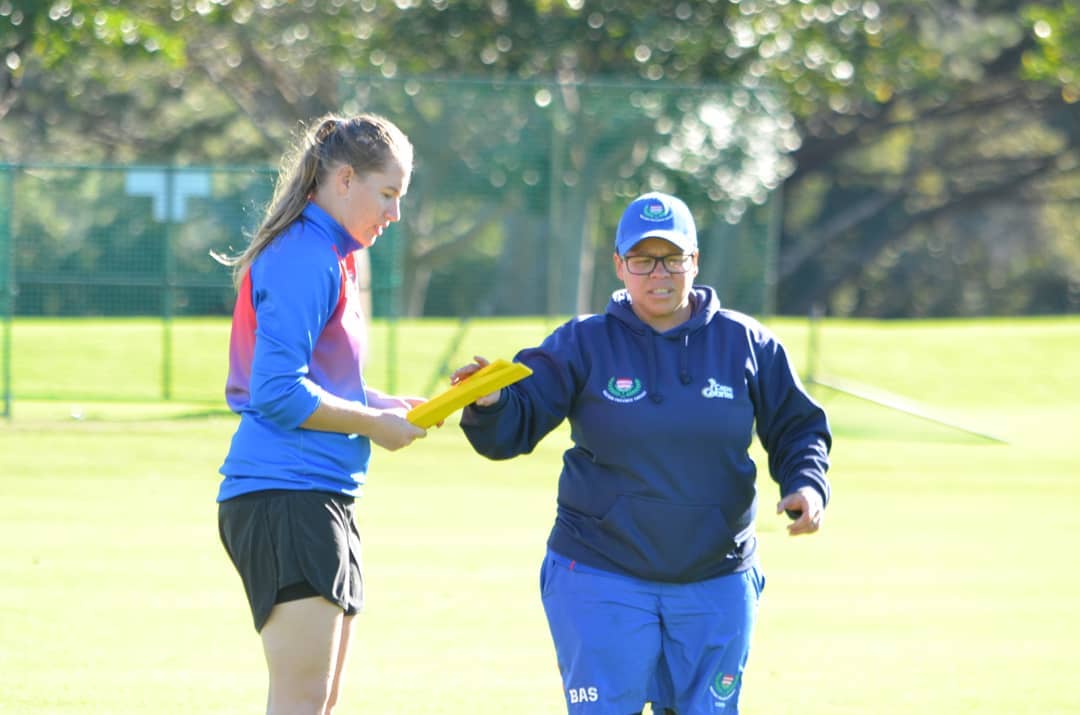
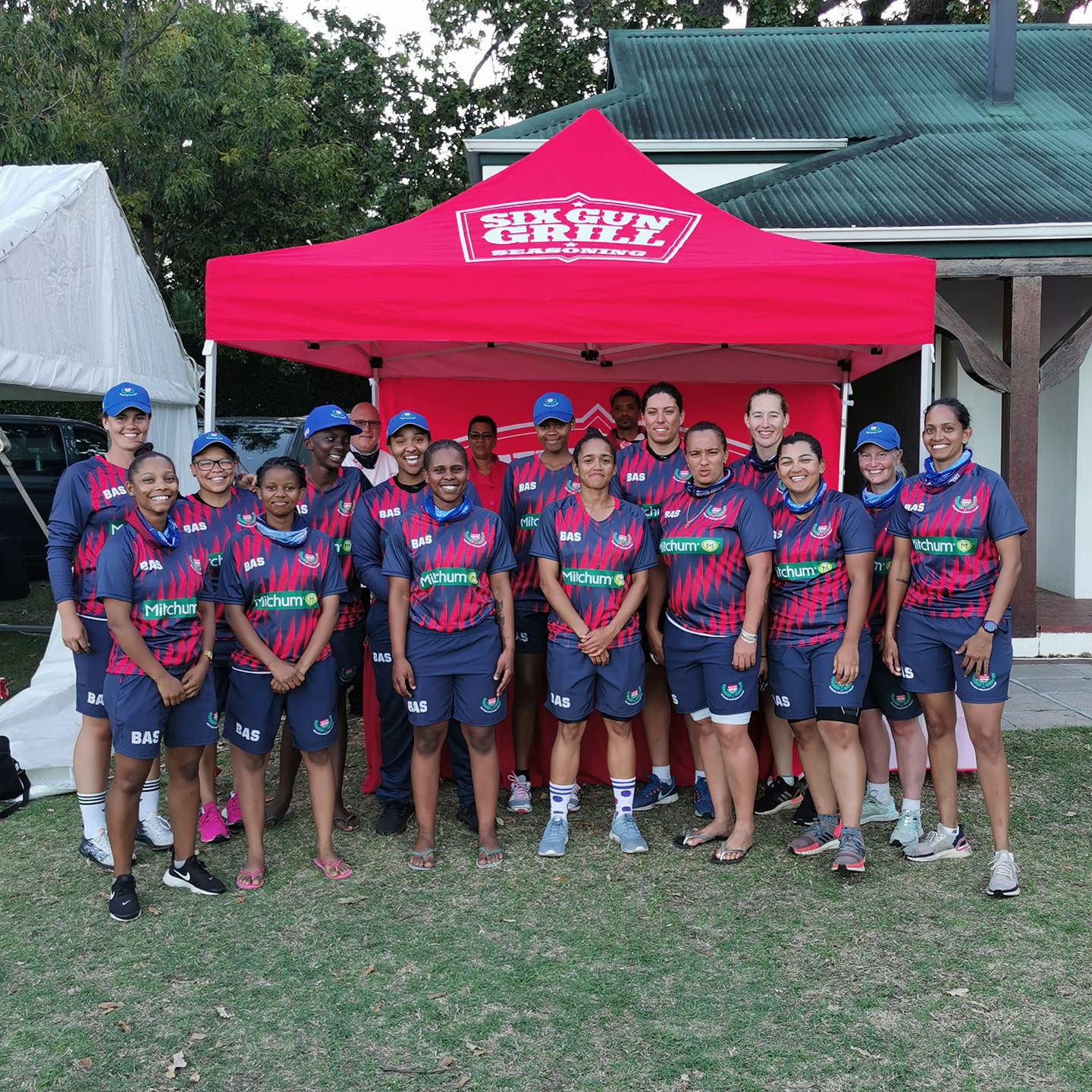
How did you come to be the Women’s and Girls Pipeline Head Coach?
The position became available 3 years ago, after the tragic passing of Coach Cobus Roodt who had done great things with the team over the years.
I applied, got shortlisted and had my interview and about a week later received my appointment phone call from Mr Nabeal Dien and so my journey with WP started in June 2018.
What is your motto as a coach?
Kindness... I believe that kindness can bring about growth, openness to learning and listening, increase trust between people and can help make players/coaches become better all round people - All through just being kind.
What are the top 5 songs in your playlist that hype you up?
Panic at the Disco - High Hopes
Panic at the Disco - Greatest Showman
Fall out Boy - Thanks for the Memories
Tiesto - The Business
Tiesto - Boom
Having played a Test in your International career, what is the kind of mental/physical preparation needed before a Test match? Is this different from the limited formats?
Yeah, I've played in one official Test but had to prepare for many... There wasn't much difference in preparing as we played Red Ball cricket at Senior Provincial level... I was an opening batter and the same characteristics are needed in a Test match as what was needed in a 50 over match - Patience, courage, tight fundamentals upfront with the new ball, knowing which line to play at and which to leave... and obviously taking responsibility to be the one to set the innings up and bat through.
Although nowadays, our ladies play a lot of White ball cricket and play a very attacking brand of cricket. There would need to be a change in how we would play the red ball game with regard to how a player would pace their innings and set themselves up because there is so much more time.
Also needing to face more red balls as it swings a lot more than the white ball, so slight adjustments in timing would be needed - Especially upfront with the new ball. I could go into so much more about this topic but let's leave it there
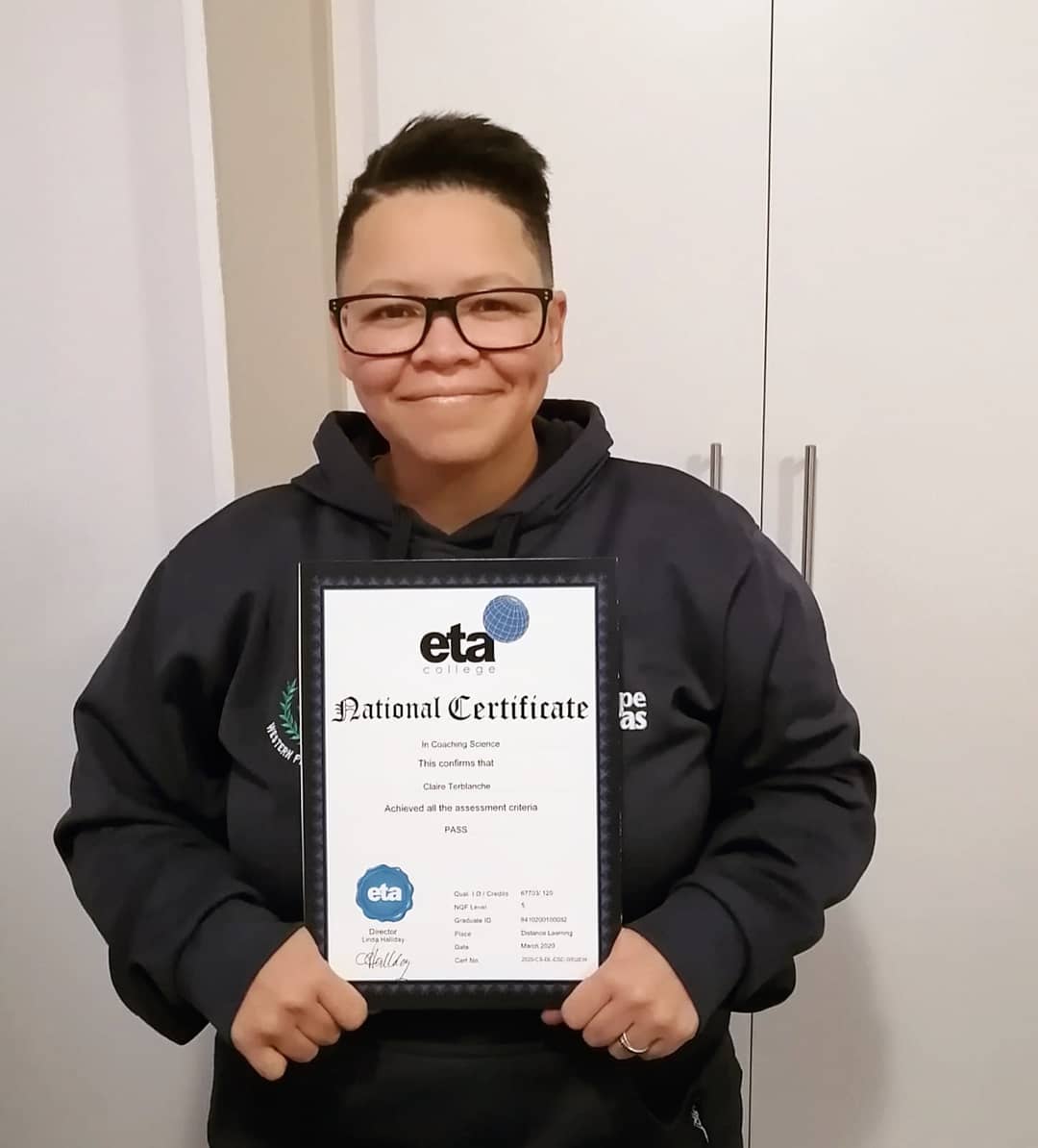

When did you decide to go into coaching?
I was still playing Senior Provincial and International cricket when I started with my coaching levels - Andre du Plessis saw something in me, more than just being able to play the game and he got me in to High Performance Coaching and mentored me along the way, still to this day he is around helping me and encouraging me.
What is the importance of the KFC Mini-Cricket festivals for involvement and development of young girls and boys getting into the game?
The KFC program is so very important as it doesn't only introduce the game to younger players but also gets coaches involved at junior school level, across the country.
The mass participation and fun of the KFC program has become so evident and exposes kids and adults alike to the beautiful game of cricket.
Whilst learning how to be in a team and share in both wins and losses as a team - this way we teach growth and rules of the sport and in learn valuable life skills.
Were it not for cricket, which other career(s) would you have pursued?
So, I would've either gone in to teaching (Cos I'd still be able to coach) or Dietetics, where I'd still be working and dealing with people 😊
Favourite Cricket player? Female & Male
Jonty Rhodes - Male
Sophia Dunkley - Female (Stayed unbiased on this one 😉)
Who motivates you most?
My Grandad was my biggest motivator, my biggest supporter - when he passed on, my whole family stepped in and I find the support of my family my greatest motivator.
Take us through a typical day as the Pipeline Head coach
This is my typical day in the off-season... During season gets a lot busier as can be expected 😊
06h00: Wake up for gym
06h30 - 07h30: Gym
08h00 - Breakfast etc
09h00: Pick up player for a morning skills session
10h00 - 12h30: Group Session with HP players
13h00 - 15h00: Admin work completed, have lunch at my desk.
15h30 - 16h30: Light weight training before team gym session (Monday and Wednesdays)
17h00 - 19h00: WP Womens Team gym and SAQ sessions (Monday and Wednesday).
19h15 - Leave to head home.

Manchester United or Liverpool?
Glory Glory Man United!!!
What are your thoughts on the importance of the development of players at grassroots level?
It is extremely important, for me, it is the most important area of our pipeline. We need to develop more quality coaches that would like to stay developing players at grassroots and not have a need or want to move to higher ranks, right away.
In this way, we develop our players and our coaches with solid foundations, thereby creating a turnaround of both quality players and coaches as people move up to the next level over time. I know it's easier said than done but it'll be fantastic for the growth of our game as the development of fundamentals will have been tightly instilled and that's a great start.
What do you do to relax?
Netflix Series, Watch Cricket (Women's and Men's), Hike, Build Lego, go fishing when I can and play some golf if I have partners 😊
As a coach in the domestic structure, what is your opinion on the importance of preparing players sufficiently for Test format in both the men’s and women’s game?
The men's structure already allows for the red ball game to be practiced and played. At National Weeks, the boys have time cricket, which later evolved into 3 day cricket in the Senior Mens space and 4 day in the Franchise space (That's how the Senior space used to work). Mens club cricket also used to have 2 day cricket at the amateur level.
Women do not play enough test matches and the systems have been adapted to allow for more white ball cricket to take place but only at Senior Women's level. Clubs and National weeks still get played with a red ball but no multi-day format.
If we have anything to go by the recent Test match - Eng vs India - Test cricket has definitely had an awakening in the women's space and the players want to play the format, to me it's still the purest form of the game and really tests players overall skill sets.
How important is the team dynamic?
Very important, a team without a positive dynamic that everyone agrees on and works towards can become a toxic space. It's about trust in each other that creates a safe dynamic and space - which goes back to my philosophy of kindness.
The CSA pipeline focuses on talent identification. What would you do in a situation where a player is 100% committed to training and development, is punctual and focused, works hard to achieve results, but lacks the sought-after talent?
Keep working with that player, keep being honest with the player about where they are along their game/path. We don't dictate opportunities but we can prepare the player as best we can, to be ready for when an opportunity arises.
Talent isn't always what nudges players ahead, it's what you do with the talent that you have that can create the opportunity for you.
Offside Maidens
Daily Show | Let's talk about it
Video Playlist
The Podcast Live Show:
Exclusive Interviews
Crossword Puzzle
Proteas Squad - Tests v Bangladesh
ISSUE 20: Crossword Answers


Magazine info
Editorial Director
Khalid Mohidin
IT and Technical Director
Faizel Mohidin
Contributors
Abhai Sawkar
Aditya Mehta
Chris Chiwanza
Emily Norris
Jessica October
Janine October
Keanan Hemmonsbey
Khalid Mohidin
Licia Woods
Marc Jacobson
Tara-Lee
Graphics
Khalid Mohidin (Cover and Graphics)
Mohammed Hoosain (CFM logo)
Images
BackpagePix
Supplied
Twitter
Facebook
Video Binge List:
On Lockdown Series
The Podcast Show
Legends with Ravi
Daily Show
